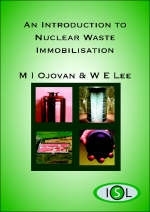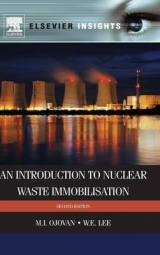
An Introduction to Nuclear Waste Immobilisation
Elsevier Science Ltd (Verlag)
978-0-08-044462-8 (ISBN)
- Titel erscheint in neuer Auflage
- Artikel merken
Safety and environmental impact is of uppermost concern when dealing with the movement and storage of nuclear waste. The 20 chapters in 'An Introduction to Nuclear Waste Immobilisation' cover all important aspects of immobilisation, from nuclear decay, to regulations, to new technologies and methods. Significant focus is given to the analysis of the various matrices used in transport: cement, bitumen and glass, with the greatest attention being given to glass. The last chapter concentrates on the performance assessment of each matrix, and on new developments of ceramics and glass composite materials, thermochemical methods and in-situ metal matrix immobilisation. The book thoroughly covers all issues surrounding nuclear waste: from where to locate nuclear waste in the environment, through nuclear waste generation and sources, treatment schemes and technologies, immobilisation technologies and waste forms, disposal and long term behaviour. Particular attention is paid to internationally approved and worldwide-applied approaches and technologies.
Michael I. Ojovan has been Nuclear Engineer of International Atomic Energy Agency (IAEA), visiting Professor of Imperial College London, Associate Reader in Materials Science and Waste Immobilisation of the University of Sheffield, UK, and Leading Scientist of Radiochemistry Department of Lomonosov Moscow State University. M. Ojovan is Editorial Board Member of scientific journals: “Materials Degradation (Nature Partner Journal), “International Journal of Corrosion, “Science and Technology of Nuclear Installations, “Journal of Nuclear Materials, and Associate Editor of journal “Innovations in Corrosion and Materials Science. He has published 12 monographs including the “Handbook of Advanced Radioactive Waste Conditioning Technologies by Woodhead and three editions of “An Introduction to Nuclear Waste Immobilisation by Elsevier – 2005, 2013 and 2019. He has founded and led the IAEA International Predisposal Network (IPN) and the IAEA International Project on Irradiated Graphite Processing (GRAPA). M. Ojovan is known for the connectivity-percolation theory of glass transition, Sheffield model (two-exponential equation) of viscosity of glasses and melts, condensed Rydberg matter, metallic and glass-composite materials for nuclear waste immobilisation, and self-sinking capsules to investigate Earth’ deep interior. Professor William E. Lee FREng is Deputy Chair of the Government advisory Committee on Radioactive Waste Management (CoRWM), and Director of the Centre for Nuclear Engineering at Imperial College London, UK. Professor Lee has been Co-Director of the Institute of Security Science and Technology (ISST), Chair in Ceramic Science and Engineering, and President of the American Ceramic Society. Previous positions at Imperial include Director of the Centre for Nuclear Engineering, Director of the Centre for Doctoral Training in Nuclear Energy (with Cambridge and The Open Universities), and Director of the Centre for Advanced Structural Ceramics. He is a member of the Government advisory committee The Nuclear Innovation and Research Advisory Board (NIRAB), the Leverhulme Trust Panel of Advisors, the Royal Academy of Engineering International Activities Committee, and the Scientific and Environmental Advisory Board Tokamak Energy Ltd. He was from Jan 2006 to Sept 2010 Head of the Department of Materials. Bill was Deputy Chair of the Government advisory Committee on Radioactive Waste Management (CoRWM) from 2007-2013, has acted as special advisor nuclear to the House of Lords Science and Technology Committee (2013) and is an IAEA Technical Expert.
1. Introduction to immobilisation
2. Nuclear decay
3. Contaminants and hazards
4. Heavy metals
5. Naturally occurring radionuclides
6. Background radiation
7. Nuclear waste regulations
8. Principles of nuclear waste management
9. Sources and characteristics of nuclear waste
10. Short-lived waste radionuclides
11. Long-lived waste radionuclides
12. Management and characterisation of radioactive waste
13. Pre-treatment of radioactive wastes
14. Treatment of radioactive wastes
15. Immobilisation of radioactive wastes in cement
16. Immobilisation of radioactive wastes in bitumen
17. Immobilisation of radioactive wastes in glass
18. New immobilising hosts and technologies
19. Nuclear waste disposal
20. Performance assessment
| Erscheint lt. Verlag | 19.9.2005 |
|---|---|
| Verlagsort | Oxford |
| Sprache | englisch |
| Maße | 165 x 240 mm |
| Gewicht | 690 g |
| Themenwelt | Technik ► Maschinenbau |
| ISBN-10 | 0-08-044462-8 / 0080444628 |
| ISBN-13 | 978-0-08-044462-8 / 9780080444628 |
| Zustand | Neuware |
| Haben Sie eine Frage zum Produkt? |
aus dem Bereich



